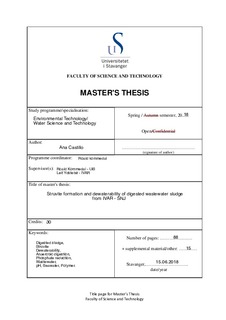| dc.contributor.advisor | Kommedal, Roald | |
| dc.contributor.advisor | Ydstebø, Leif | |
| dc.contributor.author | Castillo, Ana | |
| dc.date.accessioned | 2018-10-16T11:17:00Z | |
| dc.date.available | 2018-10-16T11:17:00Z | |
| dc.date.issued | 2018-06-15 | |
| dc.identifier.uri | http://hdl.handle.net/11250/2568217 | |
| dc.description | Master's thesis in Environmental technology | nb_NO |
| dc.description.abstract | Controlled struvite formation in digested sludge from IVARs main wastewater treatment plant “Sentralrenseanlegg Nord-Jæren (SNJ) was investigated as a way to improve the dewaterability of the sludge. Improving dewaterability leads to lower energy requirements in the subsequent sludge drying process. Controlled struvite precipitation will also reduce operational problems due to pipe and equipment clogging in the sludge line and equipment downstream the centrifuges. In addition, the nutrient recovery is of high importance in the production of fertilizers.
The effect different parameters on struvite formation was studied, such as magnesium concentration and magnesium source and pH. MgCl2 and seawater were used as magnesium source. Sludge was collected from the mesophilic anaerobic digester and taken to the lab for testing of struvite precipitation and dewaterability. A series of jar tests were performed as a basis for investigating struvite formation and Mg2+ source. In addition, a filter test procedure was carried out for determining the effect of struvite formation and pH on dewaterability of the sludge. In the tests both pH and Mg2+ dosage varied. The results of the struvite formation analyses showed that the reduction of dissolved PO4-P was higher than 90% at pH 9,0. The optimum range of struvite formation lies between pH 8,5 and 10,0. Increasing Mg2+ background concentration by addition of MgCl2 or seawater improves the struvite formation. At pH the range where struvite is most effectively formed (8,5 – 10,0), poor dewaterability of the sludge was observed. Better results on the dewatering tests were registered at pH 7,0 when seawater was used as Mg2+ source, due to the high salinity and the ratio of monovalent ions to divalent ions. Increasing the polymer dosage along with addition of about 10% seawater and no pH adjustment improved the dewaterability of the sludge most. The PO4-P reduction at this point was 70% in average.
The combination of polymer, seawater and pH seems to have the highest potential of achieving the best dewaterability of the sludge and recovery of nutrients. Further studies should focus on these parameters. | nb_NO |
| dc.language.iso | eng | nb_NO |
| dc.publisher | University of Stavanger, Norway | nb_NO |
| dc.relation.ispartofseries | Masteroppgave/UIS-TN-IKBM/2018; | |
| dc.rights | Navngivelse 4.0 Internasjonal | * |
| dc.rights.uri | http://creativecommons.org/licenses/by/4.0/deed.no | * |
| dc.subject | water science and technology | nb_NO |
| dc.subject | vann | nb_NO |
| dc.subject | environmental technology | nb_NO |
| dc.subject | wastewater | nb_NO |
| dc.subject | dewaterability | nb_NO |
| dc.subject | digested sludge | nb_NO |
| dc.subject | pH | nb_NO |
| dc.subject | polymer | nb_NO |
| dc.title | Struvite formation and dewaterability of digested wastewater sludge from IVAR - SNJ | nb_NO |
| dc.type | Master thesis | nb_NO |
| dc.subject.nsi | VDP::Teknologi: 500::Miljøteknologi: 610 | nb_NO |

